dashboard Alfa Romeo 166 2006 Owner handbook (in English)
[x] Cancel search | Manufacturer: ALFA ROMEO, Model Year: 2006, Model line: 166, Model: Alfa Romeo 166 2006Pages: 272, PDF Size: 4.17 MB
Page 12 of 272
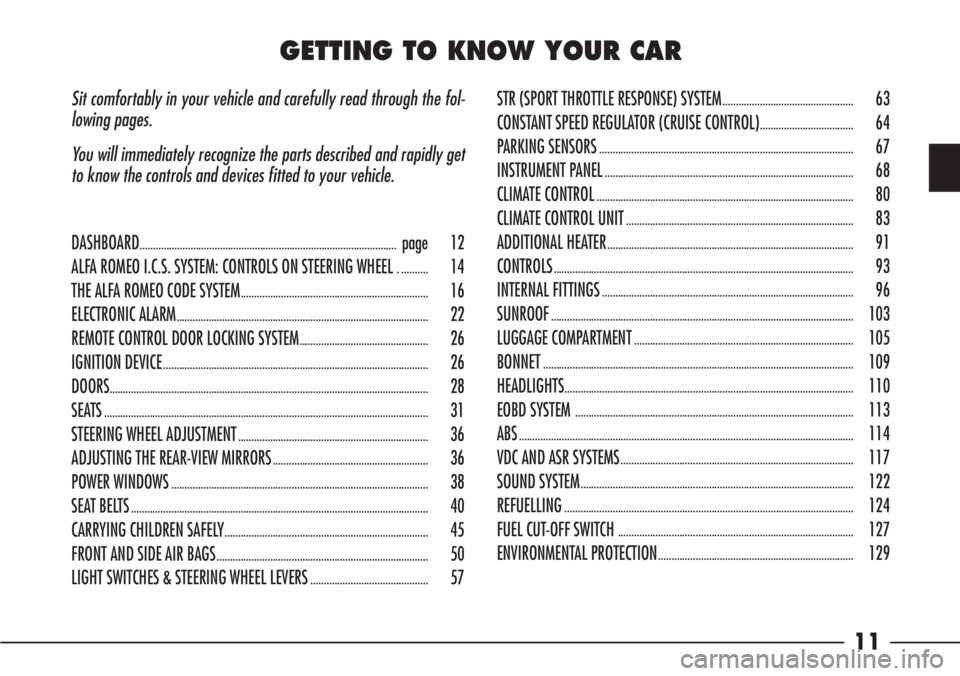
11
Sit comfortably in your vehicle and carefully read through the fol-
lowing pages.
You will immediately recognize the parts described and rapidly get
to know the controls and devices fitted to your vehicle.STR (SPORT THROTTLE RESPONSE) SYSTEM.................................................63
CONSTANT SPEED REGULATOR (CRUISE CONTROL)
...................................64
PARKING SENSORS
...............................................................................................67
INSTRUMENT PANEL
.............................................................................................68
CLIMATE CONTROL
................................................................................................80
CLIMATE CONTROL UNIT
.....................................................................................83
ADDITIONAL HEATER
............................................................................................91
CONTROLS
................................................................................................................93
INTERNAL FITTINGS
..............................................................................................96
SUNROOF
.................................................................................................................103
LUGGAGE COMPARTMENT
..................................................................................105
BONNET
....................................................................................................................109
HEADLIGHTS
............................................................................................................110
EOBD SYSTEM
........................................................................................................113
ABS
.............................................................................................................................114
VDC AND ASR SYSTEMS
.......................................................................................117
SOUND SYSTEM
......................................................................................................122
REFUELLING
............................................................................................................124
FUEL CUT-OFF SWITCH
........................................................................................127
ENVIRONMENTAL PROTECTION
.........................................................................129 DASHBOARD
................................................................................................page 12
ALFA ROMEO I.C.S. SYSTEM: CONTROLS ON STEERING WHEEL
. ..........14
THE ALFA ROMEO CODE SYSTEM
......................................................................16
ELECTRONIC ALARM
..............................................................................................22
REMOTE CONTROL DOOR LOCKING SYSTEM
................................................26
IGNITION DEVICE
...................................................................................................26
DOORS
.......................................................................................................................28
SEATS
.........................................................................................................................31
STEERING WHEEL ADJUSTMENT
.......................................................................36
ADJUSTING THE REAR-VIEW MIRRORS
..........................................................36
POWER WINDOWS
................................................................................................38
SEAT BELTS
...............................................................................................................40
CARRYING CHILDREN SAFELY
............................................................................45
FRONT AND SIDE AIR BAGS
...............................................................................50
LIGHT SWITCHES & STEERING WHEEL LEVERS
............................................57
GETTING TO KNOW YOUR CAR
Page 13 of 272
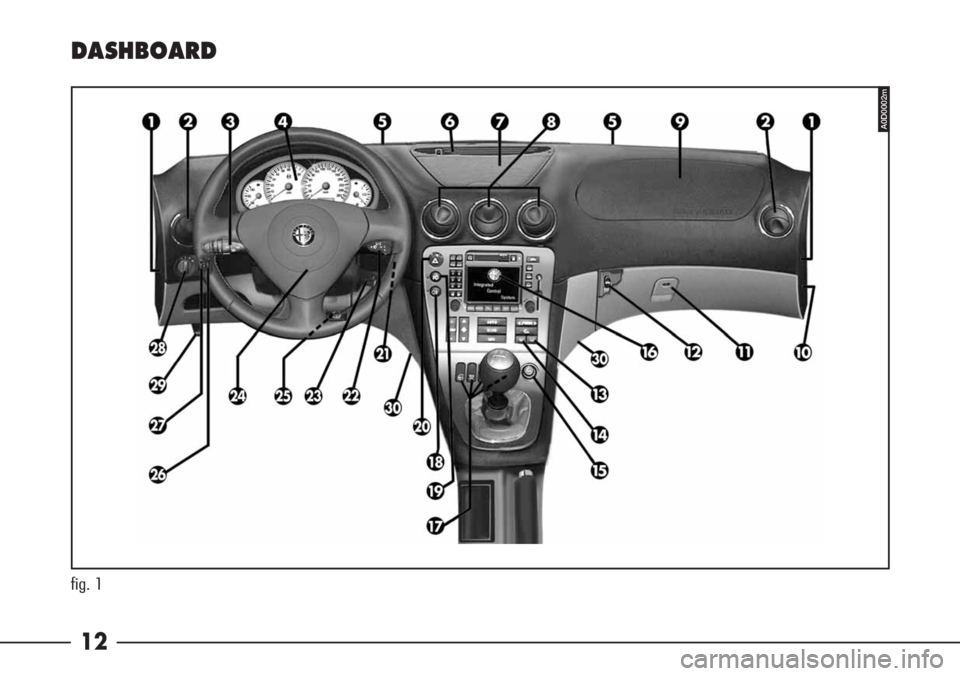
12
fig. 1
DASHBOARD
A0D0002m
Page 20 of 272
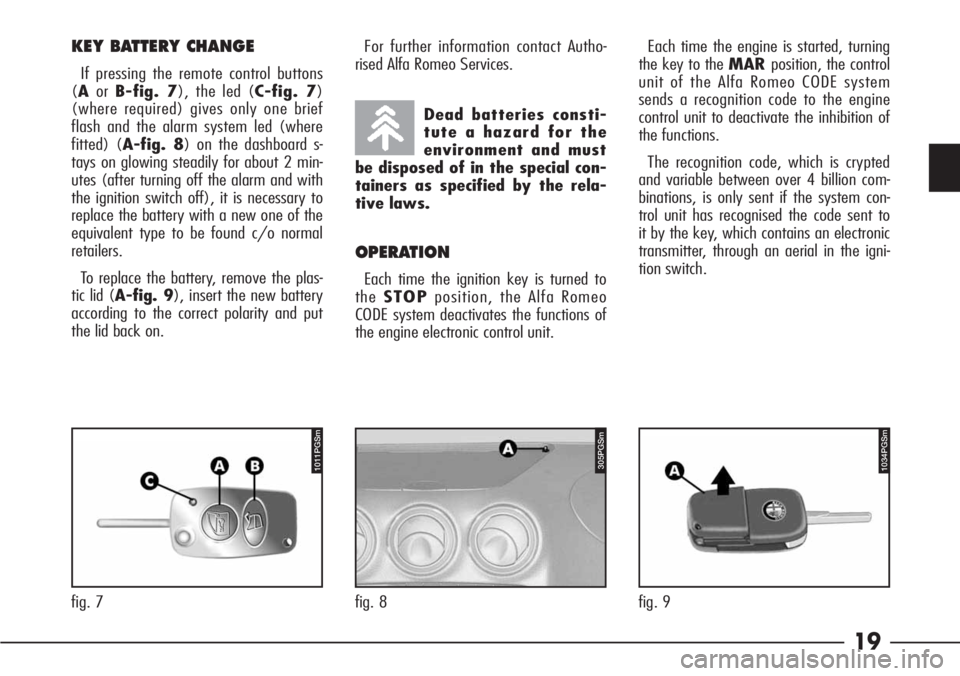
19
KEY BATTERY CHANGE
If pressing the remote control buttons
(AorB-fig. 7), the led (C-fig. 7)
(where required) gives only one brief
flash and the alarm system led (where
fitted) (A-fig. 8) on the dashboard s-
tays on glowing steadily for about 2 min-
utes (after turning off the alarm and with
the ignition switch off), it is necessary to
replace the battery with a new one of the
equivalent type to be found c/o normal
retailers.
To replace the battery, remove the plas-
tic lid (A-fig. 9), insert the new battery
according to the correct polarity and put
the lid back on.For further information contact Autho-
rised Alfa Romeo Services.
OPERATION
Each time the ignition key is turned to
theSTOPposition, the Alfa Romeo
CODE system deactivates the functions of
the engine electronic control unit.Each time the engine is started, turning
the key to the MARposition, the control
unit of the Alfa Romeo CODE system
sends a recognition code to the engine
control unit to deactivate the inhibition of
the functions.
The recognition code, which is crypted
and variable between over 4 billion com-
binations, is only sent if the system con-
trol unit has recognised the code sent to
it by the key, which contains an electronic
transmitter, through an aerial in the igni-
tion switch. Dead batteries consti-
tute a hazard for the
environment and must
be disposed of in the special con-
tainers as specified by the rela-
tive laws.
fig. 7
1011PGSm
fig. 9
1034PGSm
fig. 8
305PGSm
Page 24 of 272
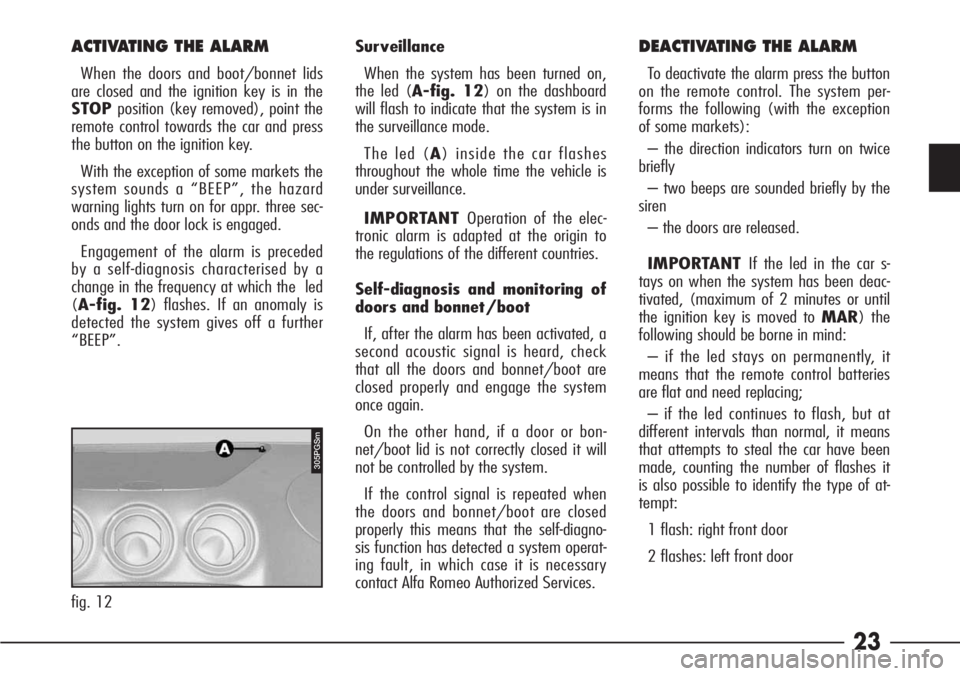
23
ACTIVATING THE ALARM
When the doors and boot/bonnet lids
are closed and the ignition key is in the
STOPposition (key removed), point the
remote control towards the car and press
the button on the ignition key.
With the exception of some markets the
system sounds a “BEEP”, the hazard
warning lights turn on for appr. three sec-
onds and the door lock is engaged.
Engagement of the alarm is preceded
by a self-diagnosis characterised by a
change in the frequency at which the led
(A-fig. 12) flashes. If an anomaly is
detected the system gives off a further
“BEEP”.Surveillance
When the system has been turned on,
the led (A-fig. 12) on the dashboard
will flash to indicate that the system is in
the surveillance mode.
The led (A) inside the car flashes
throughout the whole time the vehicle is
under surveillance.
IMPORTANT Operation of the elec-
tronic alarm is adapted at the origin to
the regulations of the different countries.
Self-diagnosis and monitoring of
doors and bonnet/boot
If, after the alarm has been activated, a
second acoustic signal is heard, check
that all the doors and bonnet/boot are
closed properly and engage the system
once again.
On the other hand, if a door or bon-
net/boot lid is not correctly closed it will
not be controlled by the system.
If the control signal is repeated when
the doors and bonnet/boot are closed
properly this means that the self-diagno-
sis function has detected a system operat-
ing fault, in which case it is necessary
contact Alfa Romeo Authorized Services.
DEACTIVATING THE ALARM
To deactivate the alarm press the button
on the remote control. The system per-
forms the following (with the exception
of some markets):
– the direction indicators turn on twice
briefly
– two beeps are sounded briefly by the
siren
– the doors are released.
IMPORTANT If the led in the car s-
tays on when the system has been deac-
tivated, (maximum of 2 minutes or until
the ignition key is moved to MAR) the
following should be borne in mind:
– if the led stays on permanently, it
means that the remote control batteries
are flat and need replacing;
– if the led continues to flash, but at
different intervals than normal, it means
that attempts to steal the car have been
made, counting the number of flashes it
is also possible to identify the type of at-
tempt:
1 flash: right front door
2 flashes: left front door
fig. 12
305PGSm
Page 25 of 272
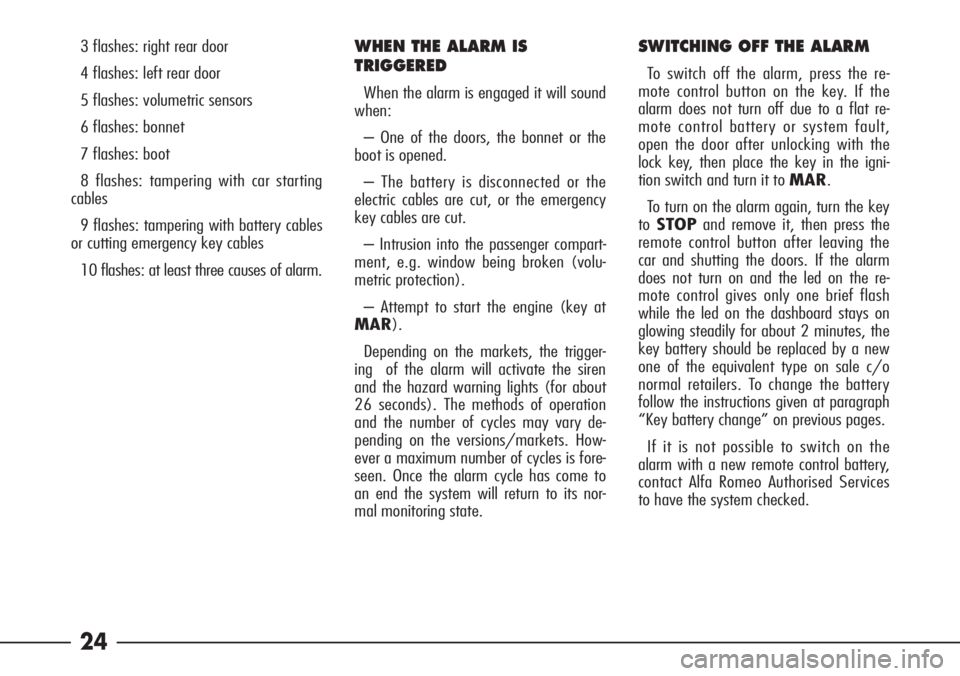
24
3 flashes: right rear door
4 flashes: left rear door
5 flashes: volumetric sensors
6 flashes: bonnet
7 flashes: boot
8 flashes: tampering with car starting
cables
9 flashes: tampering with battery cables
or cutting emergency key cables
10 flashes: at least three causes of alarm.WHEN THE ALARM IS
TRIGGERED
When the alarm is engaged it will sound
when:
– One of the doors, the bonnet or the
boot is opened.
– The battery is disconnected or the
electric cables are cut, or the emergency
key cables are cut.
– Intrusion into the passenger compart-
ment, e.g. window being broken (volu-
metric protection).
– Attempt to start the engine (key at
MAR).
Depending on the markets, the trigger-
ing of the alarm will activate the siren
and the hazard warning lights (for about
26 seconds). The methods of operation
and the number of cycles may vary de-
pending on the versions/markets. How-
ever a maximum number of cycles is fore-
seen. Once the alarm cycle has come to
an end the system will return to its nor-
mal monitoring state.
SWITCHING OFF THE ALARM
To switch off the alarm, press the re-
mote control button on the key. If the
alarm does not turn off due to a flat re-
mote control battery or system fault,
open the door after unlocking with the
lock key, then place the key in the igni-
tion switch and turn it to MAR.
To turn on the alarm again, turn the key
toSTOPand remove it, then press the
remote control button after leaving the
car and shutting the doors. If the alarm
does not turn on and the led on the re-
mote control gives only one brief flash
while the led on the dashboard stays on
glowing steadily for about 2 minutes, the
key battery should be replaced by a new
one of the equivalent type on sale c/o
normal retailers. To change the battery
follow the instructions given at paragraph
“Key battery change” on previous pages.
If it is not possible to switch on the
alarm with a new remote control battery,
contact Alfa Romeo Authorised Services
to have the system checked.
Page 46 of 272
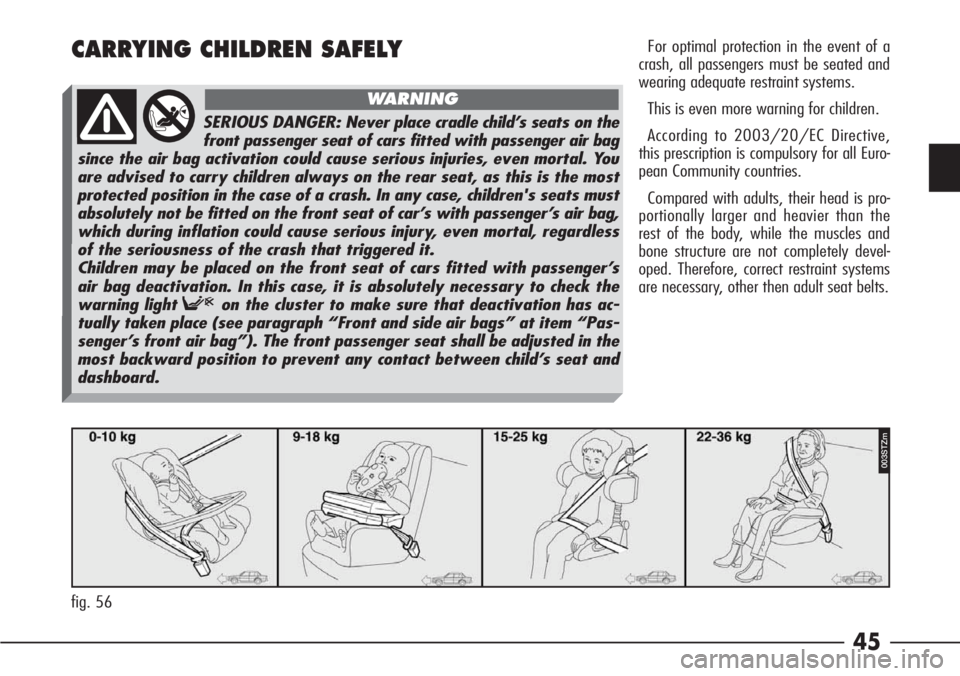
45
CARRYING CHILDREN SAFELYFor optimal protection in the event of a
crash, all passengers must be seated and
wearing adequate restraint systems.
This is even more warning for children.
According to 2003/20/EC Directive,
this prescription is compulsory for all Euro-
pean Community countries.
Compared with adults, their head is pro-
portionally larger and heavier than the
rest of the body, while the muscles and
bone structure are not completely devel-
oped. Therefore, correct restraint systems
are necessary, other then adult seat belts.
fig. 56
003STZm
SERIOUS DANGER: Never place cradle child’s seats on the
front passenger seat of cars fitted with passenger air bag
since the air bag activation could cause serious injuries, even mortal. You
are advised to carry children always on the rear seat, as this is the most
protected position in the case of a crash. In any case, children's seats must
absolutely not be fitted on the front seat of car’s with passenger’s air bag,
which during inflation could cause serious injury, even mortal, regardless
of the seriousness of the crash that triggered it.
Children may be placed on the front seat of cars fitted with passenger’s
air bag deactivation. In this case, it is absolutely necessary to check the
warning light
Fon the cluster to make sure that deactivation has ac-
tually taken place (see paragraph “Front and side air bags” at item “Pas-
senger’s front air bag”). The front passenger seat shall be adjusted in the
most backward position to prevent any contact between child’s seat and
dashboard.
AIRBAGWARNING
Page 51 of 272
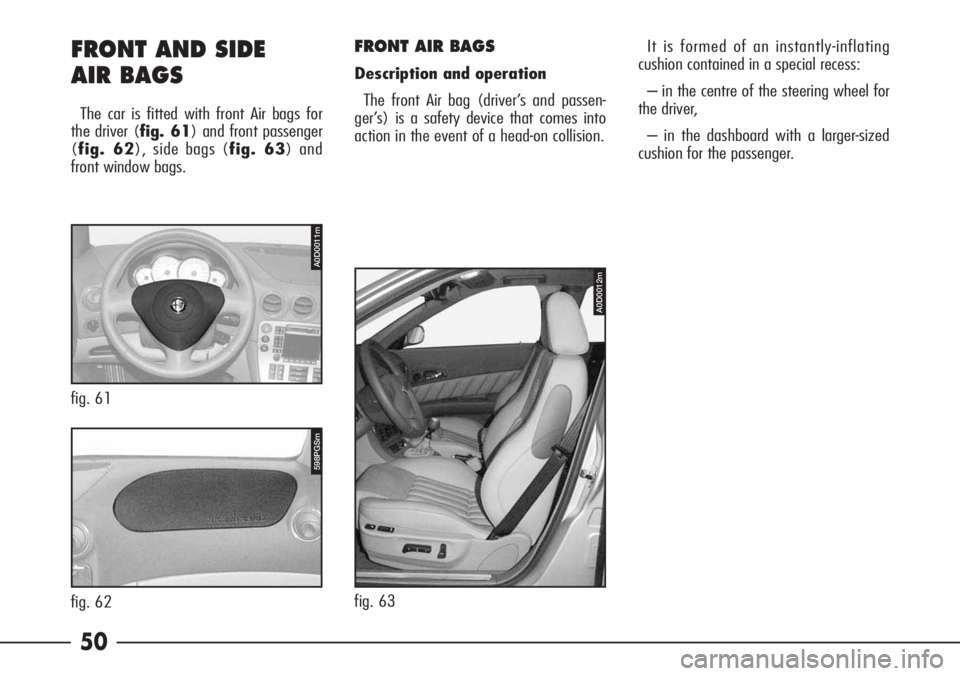
50 FRONT AND SIDE
AIR BAGS
The car is fitted with front Air bags for
the driver (fig. 61) and front passenger
(fig. 62), side bags (fig. 63) and
front window bags.
FRONT AIR BAGS
Description and operation
The front Air bag (driver’s and passen-
ger’s) is a safety device that comes into
action in the event of a head-on collision.It is formed of an instantly-inflating
cushion contained in a special recess:
– in the centre of the steering wheel for
the driver,
– in the dashboard with a larger-sized
cushion for the passenger.
fig. 62
A0D0011m
598PGSm
fig. 61
A0D0012m
fig. 63
Page 52 of 272
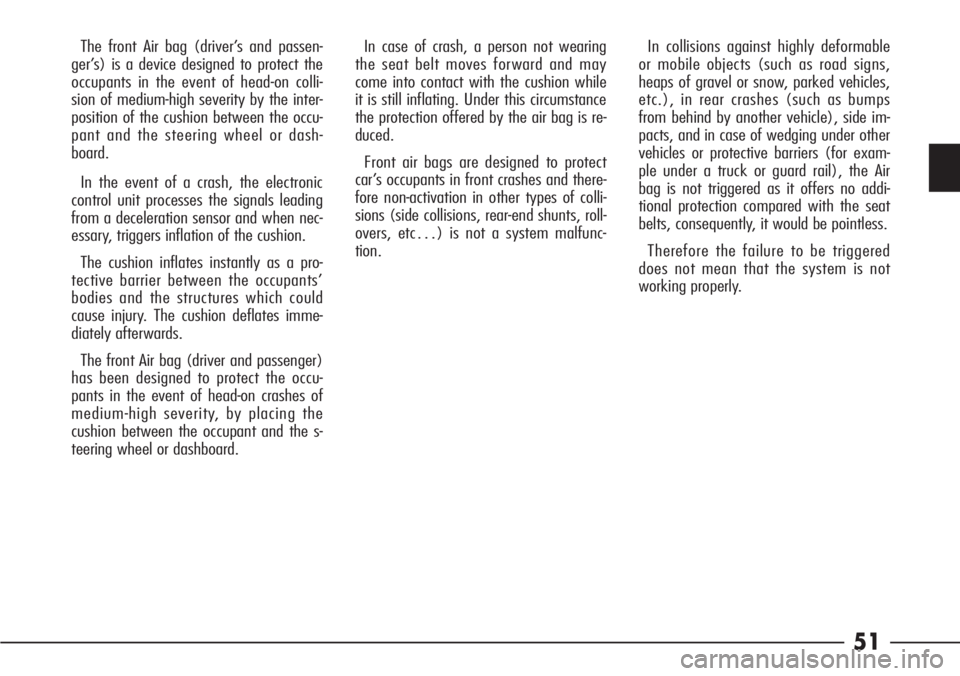
51
The front Air bag (driver’s and passen-
ger’s) is a device designed to protect the
occupants in the event of head-on colli-
sion of medium-high severity by the inter-
position of the cushion between the occu-
pant and the steering wheel or dash-
board.
In the event of a crash, the electronic
control unit processes the signals leading
from a deceleration sensor and when nec-
essary, triggers inflation of the cushion.
The cushion inflates instantly as a pro-
tective barrier between the occupants’
bodies and the structures which could
cause injury. The cushion deflates imme-
diately afterwards.
The front Air bag (driver and passenger)
has been designed to protect the occu-
pants in the event of head-on crashes of
medium-high severity, by placing the
cushion between the occupant and the s-
teering wheel or dashboard.In case of crash, a person not wearing
the seat belt moves forward and may
come into contact with the cushion while
it is still inflating. Under this circumstance
the protection offered by the air bag is re-
duced.
Front air bags are designed to protect
car’s occupants in front crashes and there-
fore non-activation in other types of colli-
sions (side collisions, rear-end shunts, roll-
overs, etc…) is not a system malfunc-
tion.In collisions against highly deformable
or mobile objects (such as road signs,
heaps of gravel or snow, parked vehicles,
etc.), in rear crashes (such as bumps
from behind by another vehicle), side im-
pacts, and in case of wedging under other
vehicles or protective barriers (for exam-
ple under a truck or guard rail), the Air
bag is not triggered as it offers no addi-
tional protection compared with the seat
belts, consequently, it would be pointless.
Therefore the failure to be triggered
does not mean that the system is not
working properly.
Page 53 of 272
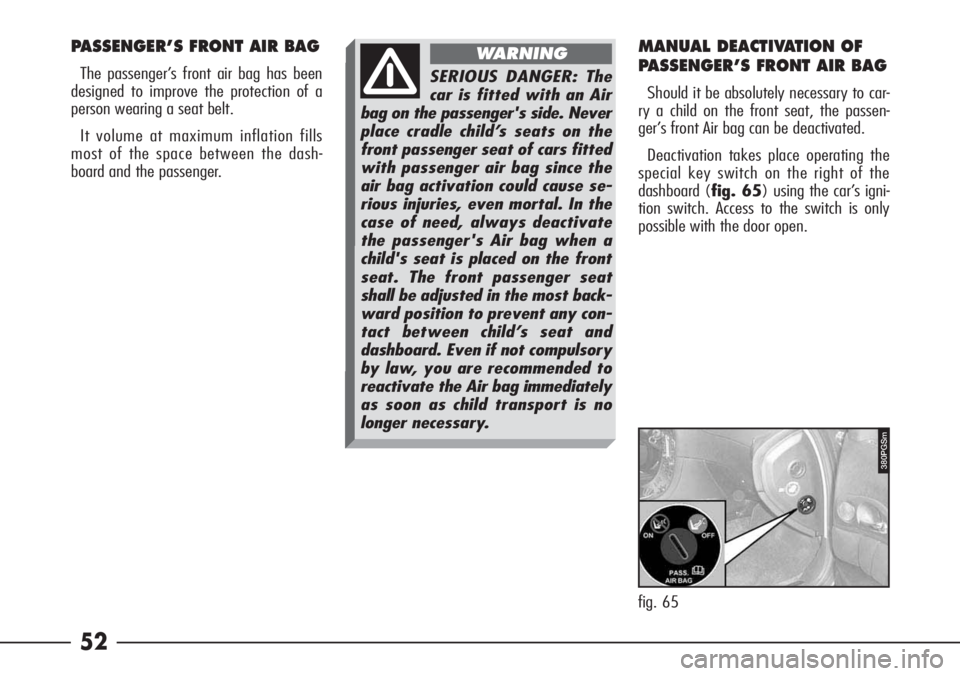
52
PASSENGER’S FRONT AIR BAG
The passenger’s front air bag has been
designed to improve the protection of a
person wearing a seat belt.
It volume at maximum inflation fills
most of the space between the dash-
board and the passenger.
MANUAL DEACTIVATION OF
PASSENGER’S FRONT AIR BAG
Should it be absolutely necessary to car-
ry a child on the front seat, the passen-
ger’s front Air bag can be deactivated.
Deactivation takes place operating the
special key switch on the right of the
dashboard (fig. 65) using the car’s igni-
tion switch. Access to the switch is only
possible with the door open.
SERIOUS DANGER: The
car is fitted with an Air
bag on the passenger's side. Never
place cradle child’s seats on the
front passenger seat of cars fitted
with passenger air bag since the
air bag activation could cause se-
rious injuries, even mortal. In the
case of need, always deactivate
the passenger's Air bag when a
child's seat is placed on the front
seat. The front passenger seat
shall be adjusted in the most back-
ward position to prevent any con-
tact between child’s seat and
dashboard. Even if not compulsory
by law, you are recommended to
reactivate the Air bag immediately
as soon as child transport is no
longer necessary.
WARNING
380PGSm
fig. 65
Page 54 of 272
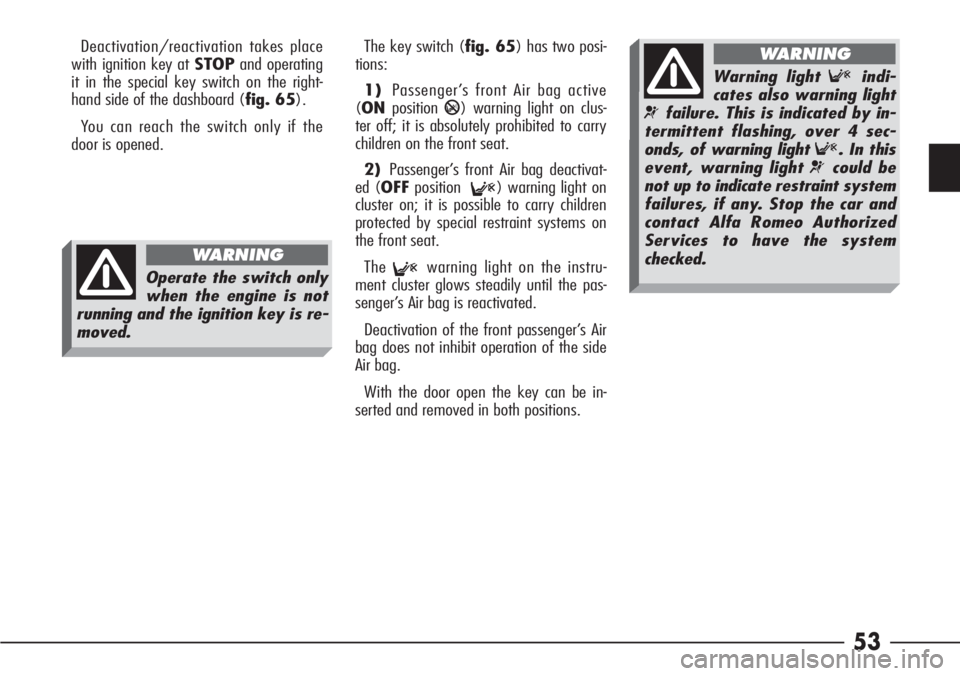
53
Deactivation/reactivation takes place
with ignition key at STOPand operating
it in the special key switch on the right-
hand side of the dashboard (fig. 65).
You can reach the switch only if the
door is opened.The key switch (fig. 65) has two posi-
tions:
1)Passenger’s front Air bag active
(ONposition
P) warning light on clus-
ter off; it is absolutely prohibited to carry
children on the front seat.
2)Passenger’s front Air bag deactivat-
ed (OFFposition
F) warning light on
cluster on; it is possible to carry children
protected by special restraint systems on
the front seat.
The
Fwarning light on the instru-
ment cluster glows steadily until the pas-
senger’s Air bag is reactivated.
Deactivation of the front passenger’s Air
bag does not inhibit operation of the side
Air bag.
With the door open the key can be in-
serted and removed in both positions.Operate the switch only
when the engine is not
running and the ignition key is re-
moved.
WARNING
Warning light Findi-
cates also warning light
¬failure. This is indicated by in-
termittent flashing, over 4 sec-
onds, of warning light
F. In this
event, warning light
¬could be
not up to indicate restraint system
failures, if any. Stop the car and
contact Alfa Romeo Authorized
Services to have the system
checked.
WARNING